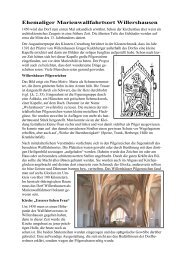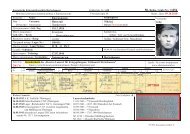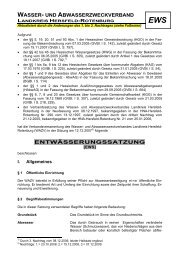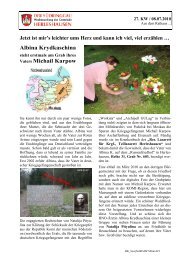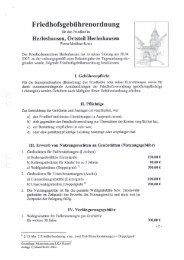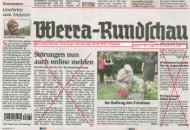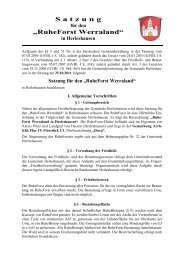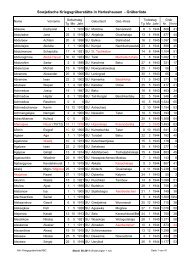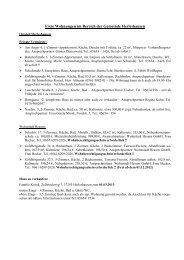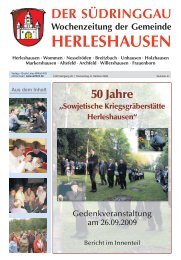Soviet War Memorial Herleshausen
Soviet War Memorial Herleshausen
Soviet War Memorial Herleshausen
Create successful ePaper yourself
Turn your PDF publications into a flip-book with our unique Google optimized e-Paper software.
<strong>Soviet</strong> <strong>War</strong> <strong>Memorial</strong> <strong>Herleshausen</strong> (2007.10.26)<br />
”Viktor Nowikow”, student, born in Moskow,<br />
died in <strong>Herleshausen</strong>, 22 years old, buried on<br />
December 27, 1944 in row 56, grave no. 1322”<br />
This is one of 1593 entries in the <strong>Herleshausen</strong><br />
registry office’s register of the deceased which the<br />
then mayor and registrar Karl Fehr kept in<br />
opposition to the wishes of the SS-leadership in<br />
Eisenach and Berlin. Nearly everywhere in<br />
Germany soviet prisoners of war were buried<br />
outside of cemeteries or outside of prisoner camps<br />
without any record being made of their names.<br />
They suffered the fate of the many who were<br />
viewed by the inhuman ideology of the NS-regime<br />
as unfit to live, a regime that even treated the dead<br />
in an unworthy manner.<br />
Mayor Fehr remained firm, even though it was<br />
potentially quite dangerous for him, and insisted<br />
on receiving death certificates from each doctor of<br />
the camp ‘Stalag IX B’, as it was regulated by the<br />
Prussian Registration Laws which had not been<br />
eradicated by the rulers in command. ”Whoever<br />
dies in my community will be registered properly<br />
and receive a decent burial”, was his moral claim.<br />
Karl Fehr was not acting purely out of a<br />
courageous sense of duty but as a compassionate<br />
human being: ”When I left home in my youth to<br />
fight in the First World <strong>War</strong> my mother said to me:<br />
My boy, don’t forget that the French and the<br />
Russians also have mothers at home who are just<br />
as distressed and fearful as I am for you.” These<br />
were his words to warrant his efforts for the <strong>Soviet</strong><br />
prisoners of war, a truly courageous and admirable<br />
stance to take. He never viewed his endeavour as<br />
a personal achievement. Far too distinct was his<br />
memory of how intensely his mother had suffered<br />
after his brother Heinrich never returned from the<br />
First World <strong>War</strong>.<br />
Karl Fehr, born 1890, died 1973, registrar (1926<br />
- 1956) and mayor (1924 – 1945 / 1948 -1956) of<br />
<strong>Herleshausen</strong>.<br />
After the Second World <strong>War</strong> Mayor Fehr was the<br />
only registrar in Germany who could furnish a<br />
complete list of all the names and dates of the<br />
deceased prisoners of war who had, thanks to<br />
him, received a decent burial, and could then hand<br />
this list over to the ‘Volksbund Deutsche<br />
Kriegsgräberfürsorge’. The Volksbund was thus<br />
able to give the families in the <strong>Soviet</strong> Union the<br />
certain news of the death of their next of kin who<br />
were up to this point merely believed to be missing<br />
in action.<br />
Through means generated by the Volksbund,<br />
gathered by members and benefactors, a worthy<br />
last resting-place was planned and completed.<br />
The surrounding wall and the entrance area was<br />
built of the same red sandstone that was primarily<br />
used to build the Autobahn viaduct close to the<br />
camp.<br />
The <strong>Memorial</strong> Cemetery was officially inaugurated<br />
on September 26, 1959 as it can be seen today.
This commemorative ceremony was attended by<br />
representatives of public life, among them also the<br />
then <strong>Soviet</strong> Ambassador in Bonn. A Russian-<br />
Orthodox priest who visited the cemetery in 1960<br />
gave the site his blessing.<br />
Foto: ~1957<br />
Karl Fehr was honored in 1967 with the<br />
Bundesverdienstkreuz. To him the many letters<br />
from the relatives of the soviet prisoners of war<br />
buried here were of far greater significance. Viktor<br />
Nowikow’s mother wrote: ”I cannot find the words<br />
to thank you for the thoughtfulness that you gave<br />
an old mother who has lost her beloved child. My<br />
eyes are never dry when I look at the photograph<br />
of my son’s gravestone. I send you my motherly<br />
gratitude for your efforts in the interest of my son<br />
Viktor and myself. How much pain the war has<br />
inflicted upon the mothers, the women, the fathers<br />
and the children ...”.<br />
The last letter that Karl Fehr received from the<br />
<strong>Soviet</strong> Union (he died in 1973 at the age of 83)<br />
came to him out of the Ukraine: ”I would have liked<br />
to have sent a bit of money for the upkeep of my<br />
father’s grave. Most of all I would like to come to<br />
<strong>Herleshausen</strong> myself if only that were possible ...<br />
Instead I am sending you some flower seeds. I’m<br />
not sure whether you know these flowers in<br />
Germany. They are flowers that develop big black<br />
oilseeds in late summer. We have them<br />
everywhere here in the Ukraine and my father<br />
always loved them so much ...”<br />
In the following year, sunflowers were blooming on<br />
Iwan Antonow’s grave.<br />
To this day and thanks to the services of the<br />
German Red Cross and the Volksbund letters still<br />
arrive in <strong>Herleshausen</strong> with requests for pictures of<br />
the cemetery and of the graves of the beloved<br />
ones. On July 13, 1971 Maria Loginowa Tkatsch<br />
from Odessa stood at her father’s grave. She was<br />
the first relative of a war victim to receive a visa for<br />
the trip to Germany: ”Unfortunately I can only tell<br />
<strong>Soviet</strong> <strong>War</strong> <strong>Memorial</strong> <strong>Herleshausen</strong>/Germany<br />
2 (2007.10.26)<br />
you through a translator how I felt when I finally<br />
stood in the beautiful forest cemetery. In the name<br />
of my mother, my siblings and all of my relatives I<br />
want to say thank you for taking care of my<br />
father’s grave over all these years ..... If you were<br />
able to speak Russian you would be even better<br />
able to understand what I wanted to say to you.”<br />
This was how she said goodbye to the Volksbund<br />
who looked after her during her visit in Germany.<br />
Iman Zeinalow of Aserbeidschan with mayor<br />
Uwe Hartmann at his father’s grave in<br />
November 1985<br />
The ‘Glasnost era’ of Michail Gorbatschow made it<br />
possible for more relatives to visit the cemetery in<br />
<strong>Herleshausen</strong>. Among them was Imam Zeinalow<br />
of Aserbeidschan who paid his final tribute to his<br />
father with the Moslem ritual ceremony of<br />
scattering earth from his homeland over his<br />
father’s grave.<br />
The origin of the camp<br />
In 1938 when the Reichsautobahn by <strong>Herleshausen</strong><br />
was being built, several barracks camps<br />
were set up to house the workers. One of these<br />
camps, located on the road to Frauenborn, was<br />
taken over by the Wehrmacht in 1940 and<br />
established as a camp for prisoners of war.<br />
First french and later soviet prisoners were<br />
interned there and used for ground work at the<br />
autobahn building site. When tuberculosis broke<br />
out in Camp ‘Ramsborn’ near Eisenach the<br />
prisoners still able to work were moved out of<br />
<strong>Herleshausen</strong>.
The ailing soviet prisoners from Ramsborn were<br />
then transferred to the ‘Stalag IX B’ which was the<br />
official name for the camp on Frauenbörner<br />
Straße. Due to the progression of the illness and<br />
the lack of supplies and care it turned into the<br />
death camp for most of those interned there.<br />
These prisoners of war were not able to or even<br />
required to perform hard labor.<br />
The former prisoner-of-war camp ‘Stalag IX B’<br />
on Frauenbörner Straße; the <strong>Memorial</strong><br />
Cemetery is off to the right, behind the woods<br />
The first of the deceased were buried near the<br />
camp and later moved to the present memorial<br />
cemetery. The prisoners who survived the life in<br />
this camp were liberated on April 4 th , 1945 by the<br />
American troops and set out on their long way<br />
home.<br />
<strong>Soviet</strong> <strong>War</strong> <strong>Memorial</strong> <strong>Herleshausen</strong>/Germany<br />
3 (2007.10.26)<br />
A place for international encounters<br />
Through the endeavours of the Volksbund it was<br />
possible to motivate young people of various<br />
different nations to see to the maintenance and<br />
upkeep of <strong>War</strong> <strong>Memorial</strong> sites throughout Europe<br />
and Russia.<br />
Thus young people from Germany, Great Britain<br />
and Norway met in 1979 for their first work<br />
assignment at the <strong>Memorial</strong> Cemetery in<br />
<strong>Herleshausen</strong>. Meetings with youth groups of<br />
<strong>Herleshausen</strong>, time for contemplation, fun and<br />
social gatherings are part of the program for the<br />
annually held youth camps which are since 1988<br />
also joined by youth representatives from the<br />
various republics of the former <strong>Soviet</strong> Union.<br />
They always return, other nations join them, meet<br />
with each other and are reminded of the terrible<br />
consequences of war which we all hope none of<br />
them will ever have to experience.<br />
In 1990 the young people stood stunned and<br />
horrified in the former concentration camp<br />
Buchenwald. Stunned by the inconceivable and<br />
reinforced in their conviction to strive towards their<br />
goal of friendship and reconciliation. They were<br />
there to help tear down and dismantle the innergerman<br />
fence close to <strong>Herleshausen</strong> - <strong>War</strong>tha.
An international youthgroup of the VDK at work,<br />
1990, Borderline <strong>Herleshausen</strong> - <strong>War</strong>tha<br />
Thanks to their recommendations the ”elders”, the<br />
former enemies, met and shook hands. <strong>Soviet</strong><br />
Veterans from Tambow (approx. 450km southeast<br />
of Moskow) came to <strong>Herleshausen</strong> in May of 1990<br />
and as early as July of the same year Germans<br />
visited prisoner of war cemeteries in the region<br />
around Tambow. Reconciliation at the graves!<br />
Veteran <strong>Soviet</strong>-Armed<br />
”<strong>War</strong> memorials are the great preachers of<br />
peace and their importance as such will<br />
continue to increase!” said Albert Schweitzer.<br />
In <strong>Herleshausen</strong> 1,593 victims of war continue to<br />
warn and admonish us with their names on their<br />
gravestones to never again allow war and hate in<br />
Europe or in the rest of the world.<br />
written by Helmut Schmidt, <strong>Herleshausen</strong> (1998),<br />
translation by Stephanie Shea, Heidelberg<br />
<strong>Soviet</strong> <strong>War</strong> <strong>Memorial</strong> <strong>Herleshausen</strong>/Germany<br />
4 (2007.10.26)<br />
Amendment<br />
50-year-old Nadjescha Drygina from Uglitsch/<br />
Wolga visited on 29.04.2006 the grave of her<br />
grandfather Iwan Skrebow. She accompanied a<br />
delegation of pupils including her nephew to the<br />
partner-borough Idstein/Taunus. They too<br />
scattered home-earth on the grave of Iwan and the<br />
great-grandchild took some earth to scatter on the<br />
grave of Iwan's wife “...for their souls to be<br />
reunited.”<br />
"Grandfather, I am so sorry, that I can only come<br />
to visit you now..." Nadjescha whose father<br />
received the message only 10 years ago that his<br />
father was entombed in <strong>Herleshausen</strong> speaks to<br />
him of her home in quiet dialogue, of her<br />
Babuschka who until her death hoped would come<br />
back, of her father the only son of Iwan who is at<br />
home, having to be looked after having had a<br />
apoplectic stroke and who is waiting for what they<br />
are going to tell him about <strong>Herleshausen</strong> and what<br />
they will show him on the many photographs they<br />
took. Tears roll down her cheeks and sprinkle the<br />
tomb slab. "Spasiwa..." again and again!<br />
Nadjeschda (in English "hope") will have a lot to<br />
tell. "Do swidanja".. until we meet again at<br />
<strong>Herleshausen</strong>... or on the German soldier's<br />
graveyard at Uglitsch! (translation by Klaus Horn;
<strong>Soviet</strong> <strong>War</strong> <strong>Memorial</strong> <strong>Herleshausen</strong>/Germany<br />
5 (2007.10.26)



